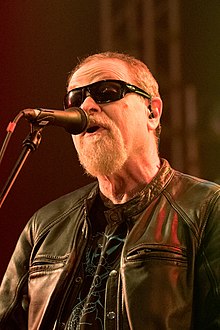This article has multiple issues. Please help improve it or discuss these issues on the talk page. (Learn how and when to remove these messages)
|
Eric Jay Bloom (born December 1, 1944) is an American musician, singer and songwriter. He is best known as the co-lead vocalist, guitar and keyboard/synthesizer player for the long-running band Blue Öyster Cult, with work on more than 20 albums. Much of his lyrical content relates to his lifelong interest in science fiction.
Eric Bloom | |
|---|---|
 Bloom in 2016 | |
| Background information | |
| Birth name | Eric Jay Bloom |
| Born | December 1, 1944 Brooklyn, New York City, U.S. |
| Genres | Hard rock, heavy metal, psychedelic rock |
| Occupation(s) | Musician, singer, songwriter |
| Instrument(s) | Vocals, guitar, keyboards |
| Years active | 1959–present |
| Labels | Columbia, CMC |
| Website | ericbloom |
Early life and education
editA native New Yorker, Bloom was born in Brooklyn, the youngest of three children, and grew up in Queens. His mother was a housewife, active in local charities and family life. His father ran a picture frame and print company in Manhattan. Bloom is Jewish.[1] Bloom attended JHS 216 (George J. Ryan Junior High School), and then moved on to Woodmere Academy and Cheshire Academy in Connecticut.[2] It was there that he purchased his first guitar, a $52 Harmony full-bodied electric.
Bloom, known as "Manny" Bloom in college, attended Hobart College in Geneva, New York, studying modern languages.
Career
editSoft White Underbelly: 1968–1971
editOne day in late 1968 some members of the band Soft White Underbelly, Donald Roeser (later Buck Dharma), Allen Lanier and Andrew Winters, entered the store. One of them spotted a photo that Bloom had put up as a joke—he had placed an 8x10 glossy of his old band Lost and Found up on the wall with all the major bands such as the Rolling Stones and The Who. One of the SWU members recognized it because Les Braunstein, their lead singer, had also been a Hobart College alumnus, and had told his bandmates about the other college band. As Bloom talked with them about the photo, they struck up a friendship. Bloom ended up doing some sound engineering for them at the Electric Circus in Greenwich Village, and they mutually impressed each other enough that in November 1968, the band's manager, Sandy Pearlman, asked if Bloom would like to become their tour manager. Bloom moved into the group's house in Great Neck, New York, in December 1968.[3][4]
Blue Öyster Cult: 1972–present
editIn April 1969, when lead singer Braunstein dropped out of the group, Bloom became the band's vocalist. The band went through several name changes, but in 1971 settled on Blue Öyster Cult. Their first album was released by Columbia Records in 1972.
In 1976, their platinum album Agents of Fortune with its hit "(Don't Fear) the Reaper" launched the band into international fame, though that particular song was sung and written by lead guitarist Buck Dharma. Both Creem readers[5] and Rolling Stone critics[6] voted "Don't Fear the Reaper" as the top single of the year.
Bloom bought his own house in Great Neck in 1976.[3]
Bloom has been one of the longtime members of the band throughout the decades, along with original member Buck Dharma. Bloom is credited as playing "stun guitar" on some Blue Öyster Cult works, a term the band uses for the distortion sound of his rhythm guitar.[7][8]
Outside work
editBloom is known for being an avid reader, especially science fiction and fantasy novels. He once sent a fan letter to English science-fiction author Michael Moorcock, and then collaborated with him on three songs. "Black Blade" was written from the point of view of Moorcock's Elric character, and the other two were "The Great Sun Jester" and "Veteran of the Psychic Wars", the latter of which was used in the original Heavy Metal movie.
Bloom also collaborated with author Eric Van Lustbader on the song "Shadow Warrior", and in 1998, 2001 and 2020 with cyberpunk author John Shirley on the Heaven Forbid, Curse of the Hidden Mirror and The Symbol Remains albums.
In 2006, Bloom began a partnership with artist Philippe Renaudin, to create and sell six elaborately painted custom-made guitars, each one of which interprets a different Blue Öyster Cult song, and each of which was played during BÖC performances.[9]
References
edit- ^ "Blue Öyster Cult Explains the Umlaut". April 17, 2013.
- ^ http://www.cheshireacademy.org/uploaded/admissions/56876_lo_res.pdf Archived February 21, 2006, at the Wayback Machine
- ^ a b Knopper, Steve (October 26, 2012). "Blue Oyster Cult's 40th anniversary CD". Newsday. Retrieved January 25, 2020.
- ^ Konig, Susan (March 12, 2000). "Blue Oyster Cult Hoping for a Resurgence". The New York Times. ISSN 0362-4331. Retrieved January 25, 2020.
- ^ "Creem Magazine Reader Polls (1973–77, 79–80)" (PDF).
- ^ "500 Greatest Songs of All Time". Rolling Stone. December 11, 2003.
- ^ Sleazegrinder (August 1, 2014). "Blue Öyster Cult: 'They wanted us to be the American Black Sabbath'". Louder Sound. Retrieved May 3, 2022.
- ^ Moseley, Willie G. (August 1998). "Buck Dharma, Regarding the Reaper and Other Recollections". Vintage Guitar. Retrieved May 3, 2022.
- ^ "Art Guitars: Series 1". Ericbloomguitars.com. Retrieved September 27, 2010.
External links
edit- Official website
- Eric Bloom Guitars – Bloom's 2006 series of custom guitars
- 1996 interview
- Classic Rock Visited – Bloom interview